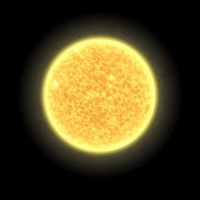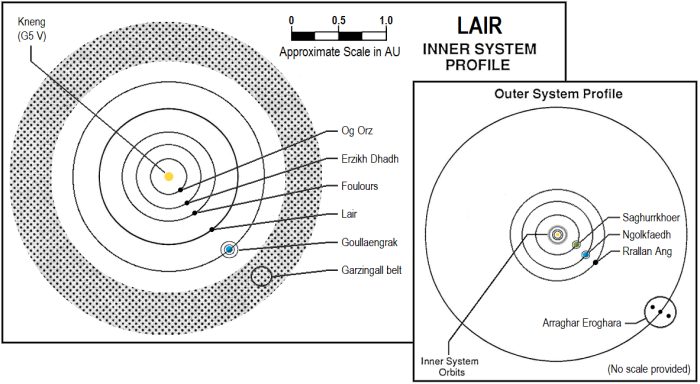Lair (system)
| Lloelldegh ("Lair") System | |||
| Grnouf/Provence 2402 | |||
| Position | Distance | Name | UWP |
| Primary | Kneng | G5 V | |
| 0 | 0.08 AU | Og Orz | YS00000-0 |
| 1 | 0.21 AU | Erzikh Dhadh | H310300-F |
| 2 | 0.39 AU | Foulours | Y630000-0 |
| 1 | 1 Diam | Servonaz | YR00000-0 |
| 2 | 5 Diam | Olou | Y300000-0 |
| 3 | 0.70 AU | Lair | A8859B9-F |
| 1 | 2 Diam | Errgh | YS00000-0 |
| 2 | 4 Diam | Sanko | YS00000-0 |
| 3 | 60 Diam | Ouksado Fan | F20031C-F |
| 4 | 1.05 AU | Goullaengrak | Large GG (Size=220) |
| 1 | 1 Diam | Raekfong | YR00000-0 |
| 2 | 3 Diam | Raekgzoe | YR00000-0 |
| 3 | 7 Diam | Knoen | Y100000-0 |
| 4 | 8 Diam | Suekh | Y100000-0 |
| 5 | 30 Diam | Vadze Aengkoe | Y330000-0 |
| 6 | 45 Diam | Fi Itsoudzi | G40011B-E |
| 7 | 60 Diam | Uerul | YS00000-0 |
| 8 | 90 Diam | Dzaer | Y200000-0 |
| 5 | 1.66 AU | Garzingnall Belt | Y000100-E (Size=0.5AU) |
| 6 | 2.69 AU | Saghurrkhoer | Small GG (Size=80) |
| 1 | 7 Diam | Atourrkou | Y300000-0 |
| 2 | 65 Diam | Rror Usuersogh | H300000-0 |
| 7 | 5.42 AU | Ngolkfaedh | Small GG (Size=60) |
| 1 | 6 Diam | Uzil | H400167-E |
| 2 | 8 Diam | Olahgz | YS00000-0 |
| 3 | 11 Diam | Knoka Llan | Y5A0000-0 |
| 4 | 60 Diam | Dhuggzung | YS00000-0 |
| 8 | 11.2 AU | Rrallan Ang | H9A5239-E |
The Lloelldegh system (aka "Lair") is centered on Kneng, an ordinary yellow main sequence star.
- The system consists of seven major planetary bodies, one planetoid belt, and three gas giant worlds.
Description (Specifications)[edit]
Stellar Data[edit]
Kneng, the system primary, is a solitary star.
- It is a yellow main sequence.
Kneng has a solitary primary star. Kneng 
Type Category Mass (Sol) Temperature (K) Luminosity G5 V Main Sequence (Dwarf) 0.98 5600 - 5660 0.93173 Unit Diameter Safe Distance Habitable Zone Jump Shadow M-Drive Limit AU 0.0091 0.0801 0.91 - 1.63 0.91 9.1 Orbit # * * 3 3 7 Remarks None
The Lair System[edit]
- A simple chart depicting the Lair system.
Inner System[edit]
Og Orz: UWP YS00000-0, orbiting at 0.08 AU (Companion Orbit), with an orbital period of 8.5 standard days.
It is an insignificant scorched ball of rock, dwarfed by many of the system's moons. Its rocky metal-poor structure discourages prospecting efforts.
Erzikh Dhadh: UWP H310300-F, orbiting at 0.21 AU (Orbit 0), with an orbital period of 36.3 standard days.
It is a small rocky world that retains a trace carbon dioxide atmosphere. Unlike Og Orz, intensely hot Erhihk Dhadh is rich with minerals and has enormous mining potential.
- Erzikh Dhadh has been the site of many boom / bust mining operations focused on harvesting various different minerals in the millennia since the Vargr first achieved space flight.
- In 1113, the Dhufokh Corporation located major deposits of rare crystals deep within the world's crust. Dhufokh quickly laid claim to the deposits, but the company is unsure how to proceed. A research station was designed and built to harness this new discovery.
Foulours: UWP Y630000-0, orbiting at 0.39 AU (Orbit 1), with an orbital period of 91.8 standard days.
It is a very hot, very poor desert world that is unusual in that it retains a very thin oxygen-nitrogen atmosphere despite its high surface temperatures.
- Unusually for an inner system world, it retains a ring system and a single major moon.
- It has extremely primitive single celled thermophilic native life that survives in the most marginal of conditions.
Habitable Zone[edit]
- Lloelldegh (Lair): UWP A8859B9-F, orbiting at 0.70 AU (Orbit 2), with an orbital period of 220.6 standard days.
It is a temperate garden world and the Homeworld of the Vargr.- Two small planetoid moons, Errgh and Sanko, orbit close to the world at 2 and 4 diameters distance, respectively.
- A small vacuum moon (Ouksado Fan) orbits at approximately 60 diameters.
Goullaengrak: UWP LGG (diameter 220,000 km), orbiting at 1.05 AU (Orbit 3), with an orbital period of 405 standard days.
It is a huge gas giant, the largest planetary body within the system
- It has a spectacular double ring system and six major moons.
- One moon, Vadze Aengkoe, was the site of an early Terraforming project and saw a major space battle in the early years of Vargr expansion out from Lair.
- Another satellite, Fi Itsoudzi, today plays host to a small tourist hostel.
Garzingnall Belt: UWP Y000100-E, a mean width of around 0.5 AU (Orbit 4), orbiting at 1.66 AU, with a mean orbital period of 2.21 standard years.
The once rich belt has been largely mined out.
- It supports a small indigenous population of miners, but most prospectors who come to the belt are transients or optimists.
Saghurrkhoer: diameter 80,000 km, orbiting at 2.69 AU (Orbit 5), with an orbital period of 4.55 standard years.
Considered to be a large gas giant, though it displays characteristics more closely related to smaller ice giant worlds.
- It has two sizable but otherwise insignificant major moons.
Outer system[edit]
Ngolkfaedh: diameter 60,000 km, orbiting at 5.42 AU (Orbit 6), with an orbital period of 13.01 standard years.
The outermost and smallest of the system's three gas giant worlds. It is a large example of an ice giant world.
- It has four major moons
- Its innermost satellite, Uzil, has rudimentary living facilities. A government science team currently occupies those facilities, engaged in astronomical studies.
Rrallan Ang: UWP H9A5239-E, orbiting at 11.18 AU (Orbit 7), with an orbital period of 38.56 standard years.
It is a large, frigidly cold, ammonia-swathed rock with hydrocarbon seas.
- The leaders of Lair's nations were ousted from power in 923. Many of those administrators voluntarily took up a life of exile on lonely Rrallan Ang. Their descendants today number in the hundreds.
Far Outer System[edit]
Three small vacuum worlds (all with UWPs of Y100000-0) orbit at the very outer edge of the system ~ (Orbit 11).
- All three share a similar orbital distance from Kneng:
- The innermost world orbits at approximately 150 AU and has an orbital period of 1895 Years.
- The middle world orbits at approximately 160 AU and has an orbital period of 2088 Years.
- The outermost world orbits at approximately 175 AU and has an orbital period of 2388 Years.
- None retain any significant satellites.
They are collectively referred to as Arraghar Eroghara, or the three lost brothers.
History & Background (Dossier)[edit]
Around -3810 the Vargr discovered jump technology and began an era of expansion. They had been exploring within the Lair system for centuries before, using sublight drives to found outposts and colonies on some of its worlds and moons.
Image Repository[edit]
TravellerMap (T5SS):
[1]
References & Contributors (Sources)[edit]
| This article has a secret. |
| This article is missing content for one or more detailed sections. Additional details are required to complete the article. You can help the Traveller Wiki by expanding it. |
- Classic Traveller Alien Module 3: Vargr
- MegaTraveller Alien - Vilani & Vargr
- GURPS Traveller: Alien Races 1
- T4 Aliens Volume 1 (Imperium Games)
